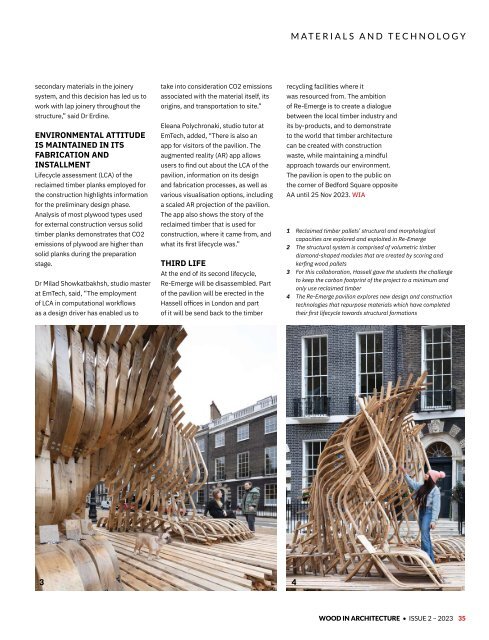WIA_ISSUE2_2023
Create successful ePaper yourself
Turn your PDF publications into a flip-book with our unique Google optimized e-Paper software.
MATERIALS AND TECHNOLOGY<br />
secondary materials in the joinery<br />
system, and this decision has led us to<br />
work with lap joinery throughout the<br />
structure,” said Dr Erdine.<br />
ENVIRONMENTAL ATTITUDE<br />
IS MAINTAINED IN ITS<br />
FABRICATION AND<br />
INSTALLMENT<br />
Lifecycle assessment (LCA) of the<br />
reclaimed timber planks employed for<br />
the construction highlights information<br />
for the preliminary design phase.<br />
Analysis of most plywood types used<br />
for external construction versus solid<br />
timber planks demonstrates that CO2<br />
emissions of plywood are higher than<br />
solid planks during the preparation<br />
stage.<br />
Dr Milad Showkatbakhsh, studio master<br />
at EmTech, said, “The employment<br />
of LCA in computational workflows<br />
as a design driver has enabled us to<br />
take into consideration CO2 emissions<br />
associated with the material itself, its<br />
origins, and transportation to site.”<br />
Eleana Polychronaki, studio tutor at<br />
EmTech, added, “There is also an<br />
app for visitors of the pavilion. The<br />
augmented reality (AR) app allows<br />
users to find out about the LCA of the<br />
pavilion, information on its design<br />
and fabrication processes, as well as<br />
various visualisation options, including<br />
a scaled AR projection of the pavilion.<br />
The app also shows the story of the<br />
reclaimed timber that is used for<br />
construction, where it came from, and<br />
what its first lifecycle was.”<br />
THIRD LIFE<br />
At the end of its second lifecycle,<br />
Re-Emerge will be disassembled. Part<br />
of the pavilion will be erected in the<br />
Hassell offices in London and part<br />
of it will be send back to the timber<br />
recycling facilities where it<br />
was resourced from. The ambition<br />
of Re-Emerge is to create a dialogue<br />
between the local timber industry and<br />
its by-products, and to demonstrate<br />
to the world that timber architecture<br />
can be created with construction<br />
waste, while maintaining a mindful<br />
approach towards our environment.<br />
The pavilion is open to the public on<br />
the corner of Bedford Square opposite<br />
AA until 25 Nov <strong>2023</strong>. <strong>WIA</strong><br />
1 Reclaimed timber pallets’ structural and morphological<br />
capacities are explored and exploited in Re-Emerge<br />
2 The structural system is comprised of volumetric timber<br />
diamond-shaped modules that are created by scoring and<br />
kerfing wood pallets<br />
3 For this collaboration, Hassell gave the students the challenge<br />
to keep the carbon footprint of the project to a minimum and<br />
only use reclaimed timber<br />
4 The Re-Emerge pavilion explores new design and construction<br />
technologies that repurpose materials which have completed<br />
their first lifecycle towards structural formations<br />
3 4<br />
WOOD IN ARCHITECTURE • ISSUE 2 – <strong>2023</strong> 35

















